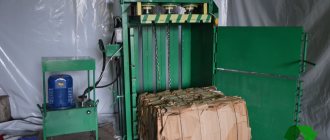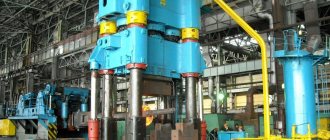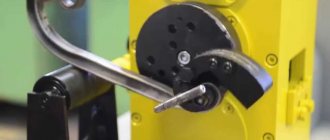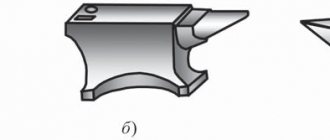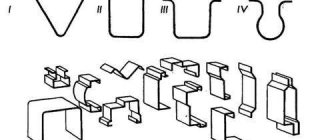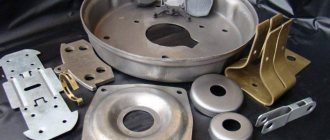Machines for performing forging and stamping operations (or rather, because some equipment is usually created for the developed technology, and not vice versa) are a common type of device for metalworking.
For example, in machine- and instrument-making enterprises or factories for the production of metal structures, for every 5 metal-cutting machines there is necessarily one piece of equipment for pressure processing. And not only metals: for example, the same PET bottles are produced on injection molding machines, which are also specialized stamping equipment.
Types of stamping technologies
The stamping process of processing blanks can be carried out using the hot or cold method. These technological varieties involve the use of special equipment and the use of certain metal processing conditions.
Cold stamping is one of the types of stamping
The hot stamping method processes workpieces that are preheated in special devices to a given temperature. Hot stamping is necessary when there is not enough equipment power to process a cold alloy. Heating devices can be electric or plasma ovens. This method requires accurate calculation of the parameters of the finished part, taking into account the shrinkage of the metal during the cooling process.
In cold stamping, parts are formed due to the mechanical pressure of the elements of the stamping press. Cold stamping is considered a more common method of metal processing. It does not require additional equipment, complex calculations or mechanical modification of parts. Thanks to this method, the strength properties of the material increase. The resulting products are distinguished by high surface quality and precision.
This is interesting: Radial drilling machine 2M55: characteristics and documentation
Forging and stamping
From the time man learned about iron, he began to look for ways to make it stronger, more reliable and at the same time give it the desired shape. Sponge iron was beaten with cold hammers to give the metal the desired shape and remove impurities from it. Then, to make it easier to solve this problem, they decided to beat it while it was hot. This method was called hot forging.
Forging is one of the most ancient methods of metal processing. In the distant past, the tools of a blacksmith’s labor were an anvil, a hammer and simple tools: bits, chisels, smoothers, etc. In the 16th century. hammers appeared that were driven by the energy of moving water (water drive).
This made it possible to increase the mass of the hammer (falling striker) by 10-15 times - up to 400 kg. The impact force of such a hammer naturally increased significantly. With the advent of steam engines, new opportunities opened up for increasing the force of a hammer blow. Almost simultaneously with the steam locomotive, the steam hammer was born.
Evolution of equipment development
Until the 15th and 16th centuries, almost all metal products were produced by private workshops and small workshops. However, the beginning of the Great Geographical Discoveries with the accompanying increase in the tonnage of sea vessels required the production of fairly large anchors and other ship equipment. It was no longer possible to forge such large parts by hand with a hammer. As a result, the first mechanical hammers powered by water power appeared.
Further, the impetus was the development of weapons and vehicles, and in the 19th century entire metalworking giants with steam equipment emerged.
The invention of hydraulic presses made it possible to introduce stamping as the main technology for mass production of products. And the further emergence of electric motors gave impetus to the development of crank presses, which form the modern basis of forging and stamping equipment.
Types of stamping equipment
To produce products from sheet metal, presses equipped with various stamps are used. During operation of the equipment, the upper component of the die moves, the lower part remains stationary.
Deformation of the workpiece occurs at the moment of contact between parts of the equipment. There are various models of stamping presses, which allows you to choose the right machine to produce the required parts.
Hydraulic Punching Machine
Presses for metal stamping are:
- crank type;
- hydraulic;
- radial forging type;
- electromagnetic type.
Crank presses are a simple type of equipment and can be double or triple acting. The presses got their name from the crank mechanism, which is the main structural element of the machine. The principle of operation of the mechanism is based on the transformation of rotational motion from the drive into reciprocating periodic movement of the press element - the slide.
Sheet stamping equipment
Sheet stamping is intended to produce products from sheet, tape and strip material without significantly changing the thickness of the workpiece. Deformation is carried out in a cold state, and when processing sheets with a thickness of over 10 mm and low-plasticity materials - in a hot or heated state.
The following types of crank, friction and hydraulic presses are used as machines for sheet stamping:
- single-action presses for punching, bending and simple drawing, having only one slide on which the punch is secured;
- double-action presses for drawing, bending, forming with two sliders. The outer slider provides clamping of the sheet workpiece, the inner slider performs the main stamping operation.
Crank presses
The most widely used in sheet metal stamping are crank presses: single-column with permanent or replaceable tables, one- and two-crank open and closed, two-column with open and closed motor, etc. Electromagnetic, hydraulic, pneumatic and screw presses can also be used. Crank presses for sheet metal stamping can create a force from 0.005 to 80 MN, but there are also more powerful ones.
Depending on the number of sliders, crank presses can be single-action (one slider), double-action (two sliders) or triple-action (three sliders). According to the number of cranks driving the slider, there are one-, two- and four-crank types. Presses can be tilting (Fig. 1) or non-tilting. The tilt of the press makes it easier to remove products from the die.
Rice. 1. Single-crank, single-action, open, tilting press, model KD2326K : 1 — electrical cabinet; 2 — flywheel-slider; 3 — upper plate of the slider; 4 - bottom plate; 5 — control panel; 6 — tilting part; 7 - base; 8 - electric motor.
With open presses, the working area is accessible from three sides. Closed presses with increased rigidity have access to the working area from the front and rear, and there are windows in the side racks for automatic feeding of the tape. For single-column presses, the frame is made in the form of a single column; for double-column presses, there is space between the columns.
Rice. 2. Diagram of a double action press
The double-action press (Fig. 2) has an outer slider 4 moving in the guides of the body 1, to which a fold holder 5 is attached, which ensures the necessary clamping of the sheet blank 8 to the matrix 7 during the stamping process.
The internal slider, to which the punch 6 is attached, ensures the main stamping operation - drawing.
In crank and eccentric presses, the folding pressure is achieved by a device, usually consisting of rollers 3 and a cam 2 mounted on the crank shaft.
Crank presses for sheet metal stamping have upper ejectors operating from stops. Ejection from the bottom of the die can be done by pads (hydraulic and pneumatic cylinders) or ejectors provided by the design of the die. In some large presses, the under-die plate can be retractable to facilitate changing dies.
2. Coordinate turret presses with program control
Coordinate-turret presses with program control have found application in both individual and serial production. The hydraulic coordinate-punching press model ZX manufactured by EUROMAC (Fig. 3) consists of a C-shaped frame 5, a table 4, a base, a turret 6, a carriage 2, on which holders 3 are attached for fastening the stamped workpiece 1 and a CNC system 7.
Let's consider the operation of a coordinate-turret press with program control using the example of a mechanical press of the Wiedematic type, model A-15, with a nominal force of 150 kN. The main movement is transmitted from electric motor 1 (Fig. 4) through a V-belt transmission to flywheel 4 located on shaft 5.
A pneumatic clutch 3 of the disc type is installed on the flywheel, connected to a brake of the 2 disc type with springs. A connecting rod 7 is mounted on the shaft 5, transmitting movement to the slider 8, in the lower part of which there is a T-shaped groove into which the T-shaped protrusions of the punch holder 9 fit.
Through the slider, the force is transmitted to the punch holders with punches 11 located in the upper disk 6 of the turret. The lower disk 14 contains matrix holders 13 with matrices 12. The turret head is driven through bevel gears 15 from a hydraulic motor 17.
Disks 6 and 14 of the turret head are fixed by the fingers of the device 16, which enter the bushings 10 from the pneumatic drive.
Rice. 3. Hydraulic jig punching press model ZX
Rice. 4. Structural and kinematic diagram of the press model A-15
The turret head of the press has 30 slots for installing replaceable dies. In Fig. Figure 5 shows a typical arrangement of replaceable dies in the turret head of the A-15 model press.
The press table of the first standard size allows you to stamp workpieces measuring 762 x 1219 mm, the second standard size - 762 x 1829 mm. The maximum thickness of the punched material is 4.75 mm.
With a thickness of the stamped workpiece of 1.9 mm, the largest diameter of the punched hole is 89 mm.
On average, a press punches about 60 holes in 1 minute, and the impact frequency on coordinate-punching presses reaches 1200 per minute. The tolerance for the distance between punched holes is ±0.1 mm.
Rice. 5. Layout of replaceable dies in the turret head of a coordinate turret press
To speed up the preparation of the press, 15 positions of the 30-position turret are equipped with standard interchangeable dies, which perform 80% of all transitions, and 15 positions are equipped with special interchangeable dies for performing special processing transitions.
In order to increase the range of punched holes in some models of coordinate-turret presses, replaceable dies are replaced with rotary drums and not one stamp, but four or six tools are installed in each slot (Fig. 6).
Rice. 6. Six tools with a maximum diameter of 24 mm in a Multitool drum of a hydraulic punching press from EUROMAC
The stamped workpiece is moved in the transverse and longitudinal directions by hydraulic drives with a maximum speed of 15.25 m/min (254 mm/s) when approaching a position and at a minimum speed when installed in a position.
In coordinate-turret presses, instead of hydraulic drives for feeding the table and carriage, electric motors with ball screw mechanisms can be installed. It is possible to use various work tables: made of hardened steel, with brushes, with balls, or combined - with brushes and balls.
For complete processing of the part, the press can be equipped with additional CNC-equipped devices. When installing a work center for machining on a press, it is possible to perform operations of milling, drilling and threading, countersinking, stripping, etc. It can be equipped with a plasma cutting device for cutting a workpiece from a sheet (Fig. 7), and a loading device.
Rice. 7. Plasma head for cutting on Plasmaform CNC coordinate turret presses from IMAC
The movement of the carriage with the stamped workpiece in the longitudinal and transverse directions and the rotation of the turret head are carried out automatically according to a program, the carrier of which is an eight-track perforated paper tape with a width of 25.4 mm.
A special device, receiving program data, consistent or not consistent with existing positions, opens the hydraulic valves, moves the carriage with the workpiece and turns the turret, forcing it to take positions corresponding to the program. Servo valves maintain the longitudinal and transverse position of the carriage, consistent with the position of the workpiece during punching a hole with a stamp. . The movement of the carriage with the workpiece in the longitudinal and transverse directions and the rotation of the turret head occur simultaneously. The press can process sheets measuring up to 1500 mm along the Y axis and up to 10,000 mm along the X axis. The punching force is 700 kN. The maximum thickness of the processed sheet is 15 mm.
Programming and manufacturing of perforated tape takes from 30 minutes to several hours, depending on the complexity of the part. At one time, the introduction of a coordinate-turret press of the Wiedematic type, model A-15, with program control at the Hewlett-Packard plant (USA) made it possible to replace seven conventional crank presses.
Sheet metal stamping presses
Hydraulic single-action frame presses type PB3434 are designed for forming and deep drawing, cutting, flanging, bending, etc. Double-action hydraulic presses, similar to PA4044, are designed for multi-operation drawing, forming, sizing and bending.
In addition, there are single-column hydraulic assembly and pressing presses, and single-column hydraulic presses for various stamping operations.
Pressure on the folding holders of hydraulic presses is transmitted from the main cylinder through springs or rubber from specially installed hydraulic and pneumatic cylinders.
Multi-position automatic sheet metal stamping machines are designed for sequential multi-transition stamping of products from metal tape with automatic transfer of the stamped part from position to position.
Automatic hydraulic presses (triple action) for finishing cutting are designed for the production of parts in one working stroke of the press with a surface roughness parameter of the contour of the part Ra = 1.25 and dimensional accuracy ranging from 7th to 11th quality.
Hydraulic press brakes are used for the manufacture of flexible parts from sheets and strips in serial and small-scale production (Fig. 8). They are equipped with CNC systems.
Rice. 8. Hydraulic press brake with CNC model IR1428F3 produced by RUMP Kuzlitmash (Pinsk)
3D programming system with simulation and collision detection capabilities
The program control (PC) database allows you to select the desired tool in automatic or manual mode or create a new one.
The press brake software allows you to create parts, development patterns and control programs on a personal computer at a separate technologist’s workstation.
Typically, a CNC press controls the Y1, Y2, X, R axes, but a CNC system with control of a large number of axes (up to 12) is possible.
The control unit automatically controls the movement of the hydraulic cylinders for feeding punches, the back stop, and controls the systems for compensating for the deflection of the upper beam and deformations of the supporting structure. The required traverse force and bending angle are automatically calculated depending on the thickness, strength and length of the material. Useful bending length is up to 6050 mm, force - 6 MN.
The press is equipped with both a control panel and a foot pedal for remote control. Operator safety in the working area of the press is ensured by a laser-photodetector system.
The workpiece is positioned using optical sensors with an accuracy of ±0.005 mm. Back stops (two or more) with a ball screw pair are equipped with a servo drive with an installation accuracy of up to 0.01 mm. Digital indication of the position of the back stop is possible.
The composite bending punch, up to 835 mm long, can be clamped hydraulically or pneumatically. Micro-adjustment of the position of the punch in height ensures an accurate bending angle along the entire length of the workpiece. The presence of a rotating beam ensures the execution of complex bends at a large angle.
Robots are used to load sheets and unload finished parts.
The ranges of values of technical parameters of press brakes are given in Table 1.
For the manufacture of cylindrical and conical vessels, aircraft bodies, etc., two-, three- and four-roll sheet bending machines are used (Fig. 9). Three-roll machines allow you to bend the ends of the sheet.
Table 1.
Technical characteristics of press brakes
| Parameter | Meaning |
| Power, MN | 0,8.. .12,5 |
| Table length, mm | 150… 12000 |
| Distance between machine columns, mm | 2050… 6200 |
| Punch stroke, mm | 140…360 |
| Pharynx depth, mm | 300…1000 |
| Bending speed, m/min | 6.. .10 |
| Maximum sheet thickness, mm | 9 |
| CNC: | |
| maximum bending angle, ° | 135 |
| travel along X/R axes, mm | 500. ..800/170.. .210 |
| punch advance/retract speed, m/min | 70. ..100/60. ..100 |
Rice. 9. CNC bending machine model RBM
Hydraulic horizontal bending and stamping presses are produced for bending with and without heating.
There are also double-roller machines with horizontal spindles (sigmachines) for straight and circular cutting, bending and flanging, roller section bending machines for cold bending of long and shaped steel, pipe bending machines with mechanical and hydraulic drives, with and without PU, hydraulic correct presses for straightening shafts and axles, etc.
Rice. 10. Automatic line for cold sheet stamping : 1 - unwinding device; 2 - tape; 3 - correct device; 4 - press; 5 — dispensing of parts from the die-cut (belt) crushing device
5. Automation and mechanization of sheet metal stamping equipment
It is very easy to do due to the fact that metal tape or strip is used as the starting blanks. The tape, rolled into a roll, and the strip are fed into the stamp most often with the help of rollers, which periodically turn at the right moment to a certain angle, ensuring the movement of the metal at the required step (Fig. 10).
Devices for automatically feeding piece workpieces to working tools are very diverse. In this case, the mechanism must ensure a certain orientation of the workpiece in space and its subsequent feeding to the working tool.
As auxiliary equipment for stamping presses, magazine devices feeding the press with blanks, mechanisms for removing parts from the die, devices for applying technological lubricant before stamping, mechanisms for removing waste, and counters for finished products have become widespread. In cold stamping, various designs of “mechanical arms” using mechanical and pneumatic clamps are widely used.
Operating principle and design of various types of presses
metal stamping workshop
Any standard stamping machine consists of the following main components: motor, transmission, actuator. The transmission and motor together make up the "drive". The main characteristic of the drive is the type of connection between the engine and the actuator: mechanical or non-rigid (liquid, gas, steam). Working parts of the press: rollers, slider, cross-beams, rollers, women.
Crank press
The machine drive rotates, the movement on the slide is converted to reciprocating.
Under the influence of this movement, the metal is processed using a stamp. All machine parts are made of durable steel and equipped with stiffeners. The movement of the slider occurs according to a strict schedule. The force on the slide reaches 8 thousand tons. Crank forging plants make it possible to speed up, simplify and reduce the cost of production of parts, saving up to 30% of rolled stock. All crank machines are divided into simple, double and triple action. The crank press is capable of performing the following types of work:
- stamping in open and closed dies;
- burr formation;
- extrusion;
- firmware;
- combined processing.
A mechanical press acts on the material with an impact, while a hydraulic press, applying less force, gets a greater effect. Therefore, the latter are used for the manufacture of large products with thick walls.
Hydraulic presses
Hydraulic Press
Capable of stamping surfaces, pressing and forging metal products. They are also used for recycling metal waste. The operation of the machine is based on increasing the force of pressure on the metal many times. The press consists of two communicating cylinders with water, between which a pipe passes. Pistons are installed in the cylinders. The operating principle of the press is based on Pascal's law.
Radial forging apparatus
Processes metal using the hot method. The blank enters the heating module, which operates on the induction principle. Here it is heated, when the metal becomes sufficiently pliable, it is fed through a conveyor to a gripping mechanism, which feeds the workpiece directly into the processing zone. Forging or stamping is carried out with strikers; during the process, the workpiece rotates all the time, due to which it is processed evenly on all sides. The press is powered by an electric motor connected by a V-belt drive to the shafts. They are placed vertically and direct movement to the connecting rod and striker, between which the slider is installed. To ensure that all movements of the mechanism are synchronous, there are copying drums. The blank holder is rotated by an electric motor through worm gears. The spring clutch slows down the movement at the right moments.
Electromagnetic press
This is the latest development, which is just beginning to be used in industry. The working body of the machine is the core of an electromagnet, which moves under the influence of an electromagnetic field. The core moves the slider or die, the springs return the slider to its original position. Such machines are characterized by high productivity and efficiency. Today, there are models with a small amplitude of movement of the working body - 10 mm and a force of no more than 2.5 tons.
Operation of a roughing stamping machine in the video:
Presses
Machine tool corporation "Stankosnab" sells the following types of presses:
- Mechanical presses;
- Single crank presses;
- Double crank presses;
- Coining presses;
- Cold extrusion presses;
- Screw arc presses;
- Hot stamping presses;
- Hydraulic presses;
- Baling presses.
- Foreign presses;
Generally speaking, presses are machines for statistical and impact processing of metallic and non-metallic materials (rubber, plastics, food, etc.). The word "press" is of French origin and literally translates as "pressure."
Presses are widely used in metal processing: forging, sheet and die stamping, pressing of gears, bearing rings, as well as in the production of other products.
Gradually, with the development of the metalworking industry, hydraulic presses, and then crank presses with an electric motor, became widespread.
Regardless of the type of machine press (hydraulic, crank, stamping press or any other), its main components and operating principle remain the same. Any press has a mandatory set of elements:
- Slider (or cross member);
- Bed with guides for the slider (crossbar) and working surface (table);
- Drive unit;
- Control mechanism;
- Means of mechanization and automation.
The mechanism of operation of the press is as follows: the slider, to which the movable part of the tool is attached, makes reciprocating movements. The stationary part of the press is attached to the table. In this case, the workpiece is located between the moving and stationary parts. Processing occurs by squeezing the workpiece between parts of the press.
According to the principle of operation, presses are divided into hydraulic, mechanical (crank presses) and hydromechanical presses.
Hydraulic presses consist of two chambers and pistons (plungers), connected to each other by a pipeline and filled with liquid. Hydraulic oils or water are often used as fluids.
Pressure is applied to the piston, which is transmitted to the liquid. The liquid, in turn, presses on the base of the second piston and, with a multiple increase in force, presses on the workpiece.
Thus, the entire operating principle of the press is justified: a small force applied at the beginning increases several times at the output.
Hydraulic presses are used in a wide variety of industries and production areas. Of course, their main area of application is metal processing: forging, stamping, extrusion, processing of metal waste and assembly work. In addition, hydraulic presses are used both in the metalworking industry and in the production of non-metallic products.
Crank presses operate on the principle of converting the rotational motion of the drive into reciprocating motion, which is transmitted to the slider and ensures its movement using a crank-slider mechanism. Only the highest quality steel is used to produce crank press shafts. At the same time, the steel is additionally hardened, which ensures the reliability and strength of the working journals of the shaft.
Hydraulic presses and crank presses are widely used not only in the metalworking industry and other manufacturing. They are used for car repair work, plumbing and many other areas.
Mechanical press
Mechanical presses are used in almost all areas of production and are used for pressing various types of materials, for example, for pressing paper, plastic containers, aluminum waste, non-ferrous metal and other bulk waste from production and human activity.
Such a press is widely used by printing plants, restaurants, hotels, fast food outlets, etc. A mechanical press can significantly reduce waste disposal costs several times, make a profit from the sale of certain types of waste, and, in principle, reduce the amount of waste.
These reasons determine the fact that a mechanical press is in constant demand among representatives of small and medium-sized businesses.
Metal press
The metal press has also found wide application in many areas of production associated with the production of large amounts of metal waste.
This type of press is used for pressing aluminum, metal waste, non-ferrous metals, metal shavings, aluminum cans and other metal products that need to be recycled.
With high power, the metal press is used for pressing car bodies and other large metal shapes.
How to order a press from the Stankosnab machine tool corporation?
In order to quickly and without unnecessary problems purchase a press from our company, you need to place an order and pay for it. After this, you will be able to pick up the press from our warehouse in Moscow. If you are in the region, you can order a press with delivery.
We will deliver your purchase to any city in Russia by road or rail, and if necessary, our specialists will carry out commissioning work.
Ordering a mechanical press from IC Stankosnab is simple and fast, because professionals work for you.
©SK Stankosnab - offers to buy inexpensive presses..
Features of open and closed dies
Closed stamping
Stamping equipment can be equipped with open or closed dies. In an open die, excess metal flows into a burr or flash that performs a specific function. The main disadvantages of this technology are: loss of alloy due to flash, reduction in product quality due to cut fibers when removing burrs.
Closed dies are used to produce simple shaped products. This flash-free technology is characterized by metal savings, no costs for cutting burrs, and high product quality due to all-round compression. Metal fibers are not cut. The closed die processing method is used for low-plasticity alloys. The main disadvantages are: the need for precise dosage of the alloy, the complex design of the die.
In modern manufacturing, stamping is primarily a preparatory operation that allows the production of parts for both electronics and aircraft or watercraft. The resulting products are subsequently subjected to welding, cutting, riveting and other processing methods depending on the technological process.
Related video: Sheet stamping
This is interesting: Types and characteristics of welding inverters
We will advise you on any questions!
Stamping, which is performed using a metal press, is one of the most common technological operations for processing this material. The essence of this procedure is to give a workpiece made of metal the required shape, for which plastic deformation is used, squeezing out a certain relief, patterns or punching holes. Presses for metal processing, depending on the list of tasks for which they are intended, differ from each other both in their technical parameters and design.
Presses for metal processing are used in any production: small-scale, serial or mass production
Overview of IPONMAC presses and their characteristics
| Model series | KD 23D | HL41 | PG41 |
| Nominal force, t | 10-80 | 40-315 | 40-315 |
| Opening height/clearance, mm | 130-280 | 800-1600 | 800-1600 |
| Table/bottom plate size, mm | up to 520*860 | up to 1400*1200 | up to 1400*1200 |
| Drive power, kW | 1,1-7,5 | 5,5-30 | 5,5-30 |
| Weight, kg | 600-5280 | 3000-36000 | 3-36000 |
Design features
All units for processing metal workpieces have approximately the same structure. Three main nodes can be distinguished. These include:
- equipment engine;
- torque transmission;
- actuating mechanism.
The first nodes form the drive system, on which the functioning of the actuator depends. Each organ is responsible for a specific result. Therefore, you should understand what types of machines there are.
Hydraulic and crank type stamping presses
From the moment people learned to perform metal forming, the work of the specialist who did it was considered one of the most honorable. Over time, the need for metal products obtained using forging technology only increased, and the actively developing industry began to need them. All this led to the fact that for forging, not the manual labor of blacksmiths, but special equipment for stamping was used.
A fairly common type of device used for forging is a kind of hammer analogue - a stamping press. Using such stamping equipment, it is possible to perform a whole list of technological operations, namely: changing the shape of the workpiece by means of its plastic deformation, forming a given relief on its surface, cutting out individual fragments, etc. On such a device, in particular, they give shape to the workpieces for the manufacture of which casting was used. Presses used for stamping operations can be crank or hydraulic.
Press diagrams: a – vertical hydraulic; b – horizontal; c – crank; g – friction; d – hydraulic screw
A crank press is used in cases where it is necessary to perform simple metal forming by pressure. The main element of such equipment, which converts the rotational movement of the drive motor shaft into reciprocating movement of the slider, is the crank mechanism. That is why a crank press is often called a stamping crank press. It is very popular both among manufacturers and private craftsmen; there are even models of a tabletop crank press. This popularity is explained not only by the high efficiency and functionality of this equipment, but also by the fact that maintenance and repair of crank presses does not cause any special problems.
Hydraulic stamping press 4-column
Hydraulic stamping presses are equipped with two working chambers in which the required pressure is created in the working fluid. The liquid under pressure enters the cylinder with another piston, through which reciprocating motion is imparted to the slide.
Types of technological operations
Technological operations with metal sheets are separating and forming.
Separation stamping operations are performed on equipment equipped with special tools. As a result, a certain part is separated from the workpiece along a straight line or a given contour. The separation of part of the sheet occurs in the following processes:
- Segment _ To perform this action, the equipment is equipped with disk, vibration devices or guillotine shears.
- Trimming . This operation separates the extreme parts of the resulting product.
- Punching . Holes of various configurations are created in a metal sheet using a stamp.
- Felling . A shaped part with a closed contour is obtained from the workpiece.
Form-changing operations are intended to create a product with different parameters and dimensions without mechanical destruction. The following types of these operations are distinguished:
- Beading. The contour of the workpiece or the internal holes are exposed to the stamp to form beads of certain sizes.
- Hood. This operation is a type of volumetric stamping, in which a spatial element is obtained from a flat material.
- Crimping To narrow the ends of a hollow workpiece, a stamp with a conical-type matrix having a narrowing working area is used.
- Flexible. As a result of the operation, the curvature of the surface changes by bending the metal and deforming the workpiece.
- Molding is a change in the shape of individual sections by reducing the thickness of the part without disturbing the external contour of the product.
- Puklyovka. Connecting two plates with a stamp without using additional elements.
Radial forging equipment for hot metal processing
A radial forging machine is used to produce shafts of various diameters with high productivity. With such a unit it is possible to set up production of up to 300 thousand finished products per year, which is quite enough to supply a large manufacturing enterprise with them.
The limited use of such a machine for metal stamping is explained not only by its high cost, but also by the fact that setting up its operating modes is a rather complex process, so it is advisable to perform it only if you plan to produce products of a certain diameter in large quantities.
Radial forging machine (RFM) ensures high stamping accuracy, producing parts with minimal allowances
The sequence of actions during which radial forging is performed is as follows.
- The part is fed into an induction device to bring it to the required heating temperature.
- After the metal acquires the required degree of plasticity, the part is sent along a roller container (rolling table) to a gripping device, with the help of which it is fed into the processing zone.
- There, the workpiece is fixed by elements of another gripping device, after which it is acted upon using special strikers.
- To ensure uniform processing on all sides, the part is constantly rotated, for which a special gripping mechanism is used.
Schemes of operation of forging machines of radial and rotary type
In order to set in motion the working mechanism of equipment for radial forging, a kinematic diagram is used, the elements of which are:
- drive motor;
- V-belt transmission;
- four vertically mounted shafts with eccentric axle boxes;
- a connecting rod with a striker and a slider attached to it.
The main automatic elements of the machine are the tracing drums, which are responsible for both the synchronous approach of the strikers and the subsequent movement of the workpiece. The rotation of the grip in which the workpiece is held is imparted by an electric motor through the worm gear elements. The braking of this mechanism, which occurs during forging, is provided by a spring clutch.
» data-lazy-type=»iframe» src=»data:image/gif;base64,R0lGODlhAQABAIAAAAAAAP///yH5BAEAAAAALAAAAAABAAEAAAIBRAA7″>
One of the types of forging equipment is a horizontal forging machine, in which the workpiece is also located parallel to the ground. Devices of this type are used primarily for forming end thickenings on rod-type workpieces. During processing, the part is located in a split matrix, the channels of which are oriented in the horizontal plane.
The processing process performed on such a machine occurs in the following sequence.
- The workpiece is placed in the stationary part of the matrix.
- The moving part of the matrix, connected to the slider, is driven by the crankshaft.
- Approaching the stationary half of the mold, the movable part of the matrix tightly covers the processed rod.
- After clamping the part with the top of the mold, the crankshaft connected to the connecting rod drives the impact punches.
- At the end of processing, all moving parts of the machine return to their original position, and the moving and stationary parts of the mold are opened.
» data-lazy-type=»iframe» src=»data:image/gif;base64,R0lGODlhAQABAIAAAAAAAP///yH5BAEAAAAALAAAAAABAAEAAAIBRAA7″>
Air driven forging hammer
A pneumatic press is an efficient, but at the same time affordable forging equipment, which is also distinguished by its compact dimensions. This machine operates using the energy of compressed air, which is supplied to the mechanisms by a built-in compressor. The operation of the compressor, the pistons of which, moving in its main cylinder, create an air flow with the required pressure, is ensured by a drive electric motor.
Since the impact mechanism of a pneumatic forging machine is operated by a crank, its design resembles that of a crank press. Before starting such equipment, the compressor and working pistons in the master cylinder are in their highest and lowest positions. When the machine is put into operation, the pistons begin to move towards each other, compressing the air between them, the pressure of which is transmitted to the crank, directly connected to the striker. For one blow of the working part of the hammer of a pneumatic machine there is one revolution of the crank mechanism. Accordingly, in order for the hammer to act on the workpiece at a higher frequency, it is necessary to ensure more intensive operation of the compressor. Even despite its small dimensions, a pneumatic press can provide a hammer impact weight of up to 1 ton.
Pneumatic forging hammer MA-4129 is designed for hot stamping in open dies
A steam-air hammer operates on a principle similar to a pneumatic press, in which the impact energy is provided by hot steam supplied directly from the boiler or through a special compressor. The mass of impacts that such equipment allows to achieve can reach up to 8 tons, and the speed of their application is 50 m/sec. Depending on the model, it can work in automatic mode, when blows are applied to the part continuously, or in manual mode, when the corresponding button or pedal must be pressed to activate the striker.
Mechanical hammers can be used for:
- free forging or forging operations in which a mold is used to form the finished product;
- stamping operations with sheet metal parts - cutting along a straight or curved line, cutting along various contours, punching holes (punching press), etc.;
- punches - making products using a special template.

